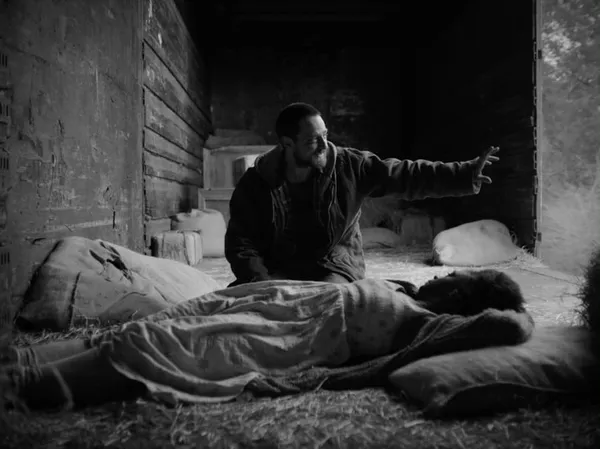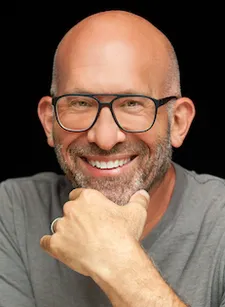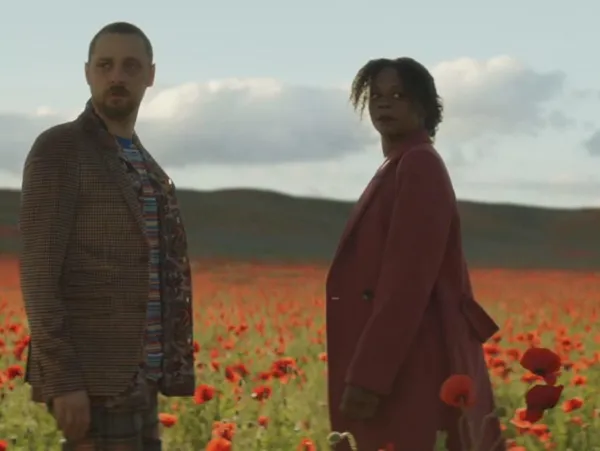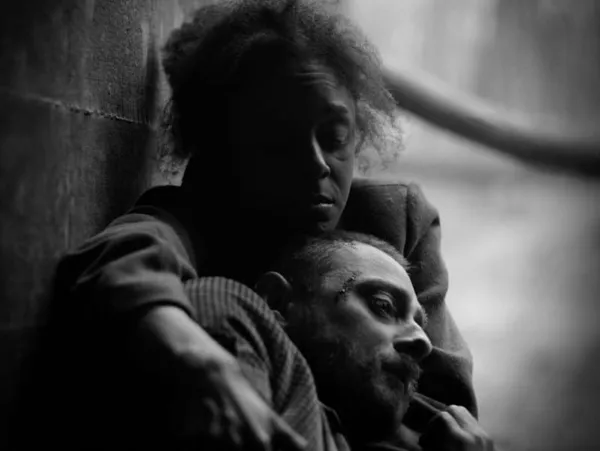Fugitive Dreams, the debut film from Jason Neulander takes us on the road with Mary (April Matthis) and John (Robbie Tann), both homeless and lonely in their own ways. We follow them on an odyssey that is as much psychological as physical - and that dips into memory and the imagined - as they encounter others, including Israfel (Scott Shepherd) and his disabled mother Providence (O-Lan Jones) and the mysterious Henri (David Patrick Kelly). Neulander adapted the film from the play Fugitive Pieces, by Caridad Svich, which he also directed for the stage - opening it out in visual terms, while retaining the intensity of the dialogue. I caught up with him to chat about the film ahead of its screening at Tallinn Film Festival.
Could you tell us a bit about adapting the play In some some ways, opening up a play in a film is an opportunity, obviously, to take it to a bigger stage. Buon the other hand, it can also be quite tricky, because of the structure of plays and their confinement.
The play is basically as written as 17 very long scenes and so, the first thing I did was to break the scenes up into smaller scenes, and just imagine a location for each of them. My process, as a screenwriter, has been to just imagine what the thing will look like on the screen - so locations, or imagined locations are a huge help with that.The play is very much inspired, I think, by Waiting For Godot, it's a very self aware script.The premise is you kind of flop these two characters down on a stage and then they start to interact with one another.
And so in a film, obviously, you're not limited to the stage, and starting to think about the motivations, particularly for Mary. After my first draft, I realised there's absolutely no reason Mary would engage with John unless she was forced to. So that really opened up the world of the adaptation, to really set the play aside and just imagine this thingas a film. Her immediate gut reaction to John is to run. So that kind of forces John, if he wants to engage with her, to have to chase her down. He wears her down. That is the way the play begins and to my mind, does so much to establish who these characters are, how they interact, and what makes their friendship, if you could call it that, that much more meaningful.
There is a lot of scripting in this film but also you open it out - was that always in your mind, to keep a sense of movement in the film.
Yeah, that was very important to me. It was a conscious choice on my part to retain dialogue. If you were to compare the screenplay to stage play, the dialogue is comparably stripped down. But to me, it was very much about the conversations that they were having, and how those conversations evolved. I've written my share of much more traditional screenplays, and one of the rules of thumb that they teach you is try to keep your scenes no longer than two pages. An absolute no-no is to have a scene longer than four pages, there's all these structural restrictions. And I was like, you know, what, this is going to be a weird experimental film, and I am simply not going to worry about mainstream Hollywood rules for this project.
Did you have fun breaking the rules - was it freeing to go on your own voyage of discovery with the material.
Yeah, it was. Part of it was form meets content and I gave a tremendous amount of thought to the structure. On the one hand, the film structure is pretty fluid, like, there is no plot in the traditional sense of the word. And then on top of that, you're seeing the action play out through the eyes of the characters themselves. These characters see the world in a totally different way than we do. So I knew that that was going to be a key way to that we, as a viewer, were going to experience the film.
I watched the film Ida and one of the things that blew my mind about that film was the four by three aspect ratio. Seeing that movie in four by three specifically made me think a lot about Fugitive Dreams and how this movie was harkening back in many ways to this, like, particular take on a classic Hollywood genre from a long time ago. And that was part of the decision to allow there to be dialogue because movies from the 1930s were dialogue driven. Also, one of the things that's kind of baked a little bit into the play, and I thought would be really fun to play with on the screen is the Wizard oOf Oz. So, you know, going from black and white to colour and using that in a way that both reflects back on the Wizard Of Oz, but also doesn't - it's kind of the upside down version.
How did you find working with the cinematographer Peter Simonite? Because you've got to really be on the same page to do something like that, when you're moving from monochrome to colour and back.
I created this lookbook that used photographs of the great photographers of the 1930s, who were employed by the WPA - you know, the Roosevelt administration hired photographers to shoot the Dust Bowl and all that stuff - and Dorothea Lange specifically. Peter really wanted to photograph it in a way that captured the essence of the way films were shot back those days. So we used contemporary lenses that are designed to have a similar look as the older lens. And then when Peter created a kind of a lookbook going into the shoot, that was so thoroughly researched. And he listed so carefully to what I had in mind, from those older Hollywood movies to those photographs, that connection, all the way through to Wim Wenders and Jim Jarmusch, who had a big influence on me as well. I wasn't sure if the film would work to set so much of it in this one location, on the train, you know, about 20 minutes of the film. But then watching the Jarmusch movie Down By Law, where about 20 minutes of that film takes place in the jail cell, without even a break. And I thought, this is really doable. Again, it's counter to the rules of cinema to put characters in this totally confined space with limited possibilities of camera angles, all that stuff, but I was like, you know, Jarmusch pulled it off pretty darn well.
The scripting lends the focus to the actors, so they are key to the film, how was the casting?
It was amazing. After I decided that I wanted to adapt this play into a movie. The first person I called, of course, was the playwright. But then after that, the second phone call I made was to April Mathis, who plays Mary to ask if she'd be game for doing it. She and I had worked 20 years before, in Austin, Texas, before she came to New York. And she reminded me of something that I'd totally forgotten, which was that when I directed the play, back in 2002, I had asked April to be in the play. She had just moved to New York, and she told me she couldn't do it, she needed to focus on her New York. work. So clearly I'd had her in my mind for the role for a long time. The second person I called was O-Lan because I had a feeling that she would just jump on the weird, experimental aspect of that character, you know, and find something. She's such a fearsome personality herself, that she would bring some of that fearsomeness to the role. After that, it was a little bit of a slower process. I was trying to figure out who to cast for John and when I reached out to this one agent for a different actor, she mentioned Scott Shepherd. And I couldn't see Scott as John. But I was like, "Oh, my gosh, he'd make an incredible Israfel". And then, for John, that casting process lasted up until about three days before rehearsals started.
That sounds nerve-wracking.
Weirdly, it wasn't. I knew that we would find somebody. I had such a clear understanding of the character and I just trusted the process. Maybe a month before that, I was starting to get nervous, and I talked to a bunch of different casting directors and friends who directed films, and everybody said, "Don't worry about it. It's totally normal to cast roles at the last possible second". I didn't know Robbie's work at all, prior to his tape he sent in with it with his audition. But April had pointed me to him, she had done a little bit of work with him. His audition had this amazing vulnerability to it. I was like, if I can get playfulness, in conjunction with this vulnerability out of this actor, If April hadn't vouched for him, I might have been a little more nervous about it, but I trusted her. And then, with David Patrick Kelly that was, you know, just incredibly fortuitous. In addition to his television and film work, he’s a well known theatre actor in New York. And so April and he knew each other because of that. We sent the script to him, and I didn't know how he was going to respond. I didn't know him personally at all. And three days laterr, I get this personal email from him, super short – “This script is so fearsome and brave. I love it. I love this character. I hope I can be a part.”
It's interesting that you talk about harking back to a different era because the whole film is a sort of meditation on memory and the way that people experience memories. How somebody’s impression of somebody else's memory can differ radically from the actual memory. And, indeed, from the actuality of the experience, in that somebody may not remember the experience as it actually was their memory may be different.
I don't know if I put it into those words but what I was definitely interested in was how our perception of reality is a subjective. And, John, I think you get a sense of the fact that he’s a little bit unhinged right out of the gate. The title of the play is Fugitive Pieces and I did an intentional shift because I wanted to bring out this idea of dream as perception and perception as dream – and the American dream, too. For me, Henri represents John’s inner demons.
The film reminded me of Waiting For Godot was that something you were thinking about when you first read the play?
I think maybe for me, it was probably less consciousness. But as you said it, I realised that it was absolutely true, that it's like the reverse of Waiting for Godot. So in Waiting for Godot, these guys are stuck in the same spot next to that tree for eternity, you know? Right, as act two begins, you realise this is repeating itself, maybe always. And in Fugitive Dreams, we're continuing, like, we start in motion, and we kind of never stop. But there’s the idea that these characters are kind of on this road to nowhere, and they don't even know what their destination is.
One of the expectations of a road movie is that at some point in the first act, one character or another is going to make an announcement as to where they're headed. And then you know what the goal is, I think every movie ever has that to one degree or another. So in this one, you don't get that in the first act. You know, you do get it in the second act, but it's so strange, it's so impossible, that I don't think you trust that they're actually going to get to that place.
You have a background in theatre direction but now you’ve got your first film under your belt, what do you think will be next for you?
I loved this process. I really felt like it took all these skills that I built as a theatre director and writer and stretched me - it was so much fun. I’m not a young person a more so to feel like I've been stretched in this way just made me feel like I was 23 all over again, which is really magical. And so, I, my next project is going to be another movie, which we're already working on a little bit, but I also had been talking with April about doing a theatre piece. I kind of put it out to her, like, “What's the role that you would love to play that you never could imagine being cast as and let's do that play.” She mentioned something to me that I did not expect her say it. And I'm like, “All right, once this whole COVID thing has passed, and we can do plays again, yes.”

























